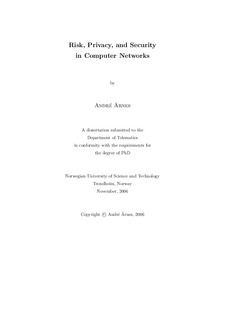| dc.contributor.advisor | Knapskog, Svein J | nb_NO |
| dc.contributor.author | Årnes, Andre | nb_NO |
| dc.date.accessioned | 2014-12-19T13:29:28Z | |
| dc.date.available | 2014-12-19T13:29:28Z | |
| dc.date.created | 2007-10-26 | nb_NO |
| dc.date.issued | 2006 | nb_NO |
| dc.identifier | 122899 | nb_NO |
| dc.identifier.isbn | 82-471-8234-3 | nb_NO |
| dc.identifier.uri | http://hdl.handle.net/11250/249717 | |
| dc.description.abstract | With an increasingly digitally connected society comes complexity, uncertainty, and risk. Network monitoring, incident management, and digital forensics is of increasing importance with the escalation of cybercrime and other network supported serious crimes. New laws and regulations governing electronic communications, cybercrime, and data retention are being proposed, continuously requiring new methods and tools.
This thesis introduces a novel approach to real-time network risk assessment based on hidden Markov models to represent the likelihood of transitions between security states. The method measures risk as a composition of individual hosts, providing a precise, fine-grained model for assessing risk and providing decision support for incident response. The approach has been integrated with an existing framework for distributed, large-scale intrusion detection, and the results of the risk assessment are applied to prioritize the alerts produced by the intrusion detection sensors. Using this implementation, the approach is evaluated on both simulated and real-world data.
Network monitoring can encompass large networks and process enormous amounts of data, and the practice and its ubiquity can represent a great threat to the privacy and confidentiality of network users. Existing measures for anonymization and pseudonymization are analyzed with respect to the trade-off of performing meaningful data analysis while protecting the identities of the users. The results demonstrate that most existing solutions for pseudonymization are vulnerable to a range of attacks. As a solution, some remedies for strengthening the schemes are proposed, and a method for unlinkable transaction pseudonyms is considered.
Finally, a novel method for performing digital forensic reconstructions in a virtual security testbed is proposed. Based on a hypothesis of the security incident in question, the testbed is configured with the appropriate operating systems, services, and exploits. Attacks are formulated as event chains and replayed on the testbed. The effects of each event are analyzed in order to support or refute the hypothesis. The purpose of the approach is to facilitate reconstruction experiments in digital forensics. Two examples are given to demonstrate the approach; one overview example based on the Trojan defense and one detailed example of a multi-step attack. Although a reconstruction can neither prove a hypothesis with absolute certainty, nor exclude the correctness of other hypotheses, a standardized environment combined with event reconstruction and testing can lend credibility to an investigation and can be a valuable asset in court. | nb_NO |
| dc.language | eng | nb_NO |
| dc.publisher | Fakultet for informasjonsteknologi, matematikk og elektroteknikk | nb_NO |
| dc.relation.ispartofseries | Doktoravhandlinger ved NTNU, 1503-8181; 2006:227 | nb_NO |
| dc.subject | Network security | en_GB |
| dc.subject | Privacy | en_GB |
| dc.subject | Risk assessment | en_GB |
| dc.subject | Intrusion detection | en_GB |
| dc.subject | Pseudonymization | en_GB |
| dc.subject | Digital forensics | en_GB |
| dc.subject | TECHNOLOGY: Information technology: Computer science | en_GB |
| dc.title | Risk, Privacy, and Security in Computer Networks | nb_NO |
| dc.type | Doctoral thesis | nb_NO |
| dc.source.pagenumber | 385 | nb_NO |
| dc.contributor.department | Norges teknisk-naturvitenskapelige universitet, Fakultet for informasjonsteknologi, matematikk og elektroteknikk | nb_NO |
| dc.description.degree | PhD i informasjons- og kommunikasjonsteknologi | nb_NO |
| dc.description.degree | PhD in Information and Communications Technology | en_GB |
